SESAM Mode-Locked Yb:Ca3Gd2(BO3)4 Femtosecond Laser
Abstract
:1. Introduction
2. Experimental Setup
3. Continuous-Wave Laser Operation
4. SESAM Mode-Locked Operation
5. Conclusions
Author Contributions
Funding
Institutional Review Board Statement
Informed Consent Statement
Data Availability Statement
Conflicts of Interest
References
- Chenais, S.; Druon, F.; Forget, S.; Balembois, F.; Georges, P. On thermal effects in solid-state lasers: The case of ytterbium-doped materials. Prog. Quantum. Electron. 2006, 30, 89–153. [Google Scholar] [CrossRef] [Green Version]
- Cortes, A.G.; Torres, J.M.C.; Han, X.; Cascales, C.; Zaldo, C.; Mateos, X.; River, S.; Griebner, U.; Petrov, V.; Valle, F.J. Tunable continuous wave and femtosecond mode-locked Yb3+ laser operation in NaLu(WO4)2. J. Appl. Phys. 2007, 101, 063110. [Google Scholar] [CrossRef] [Green Version]
- Sévillano, P.; Georges, P.; Druon, F.; Descamps, D.; Cormier, E. 32-fs Kerr-lens mode-locked Yb:CaGdAlO4 oscillator optically pumped by a bright fiber laser. Opt. Lett. 2014, 39, 6001–6004. [Google Scholar] [CrossRef] [PubMed] [Green Version]
- Serrano, M.; Pérez, J.O.Á.; Zaldo, C.; Sanz, J.; Sobrados, I.; Alonso, J.; Cascales, C.; Díaz, M.F.; Jezowski, A. Design of Yb3+ optical bandwidths by crystallographic modification of disordered calcium niobium gallium laser garnets. J. Mater. Chem. C 2017, 5, 11481–11495. [Google Scholar] [CrossRef]
- Loiko, P.; Mateos, X.; Wang, Y.; Pan, Z.; Yumashev, K.; Zhang, H.; Griebner, U.; Petrov, V. Thermo-optic dispersion formulas for YCOB and GdCOB laser host crystals. Opt. Mater. Express 2015, 5, 1089–1097. [Google Scholar] [CrossRef]
- Chen, X.W.; Wang, L.S.; Liu, J.H.; Guo, Y.F.; Han, W.J.; Xu, H.H.; Yu, H.H.; Zhang, H.J. High-power CW and passively Q-switched laser operation of Yb:GdCa4O(BO3)3 crystal. Opt. Laser Technol. 2016, 79, 74–78. [Google Scholar] [CrossRef]
- Liu, J.H.; Han, W.J.; Chen, X.W.; Dai, Q.B.; Yu, H.H.; Zhang, H.J. Continuous-wave and passive Q-switching laser performance of Yb:GdCa4O(BO3)3 crystal. IEEE J. Sel. Top. Quantum Electron. 2015, 21, 1600808. [Google Scholar]
- Loiko, P.; Serres, J.M.; Mateos, X.; Yu, H.; Zhang, H.J.; Liu, J.H.; Yumashev, K.; Griebner, U.; Petrov, V.; Aguilo, M.; et al. Thermal lensing and multiwatt microchip laser operation of Yb:YCOB Crystals. IEEE Photon. J. 2016, 8, 1501312. [Google Scholar] [CrossRef]
- Yoshida, A.; Schmidt, A.; Petrov, V.; Fiebig, C.; Erbert, G.; Liu, J.H.; Zhang, H.J.; Wang, J.Y.; Griebner, U. Diode-pumped mode-locked Yb:YCOB laser generating 35 fs pulses. Opt. Lett. 2011, 36, 4425–4427. [Google Scholar] [CrossRef] [PubMed]
- Druon, F.; Balembois, F.; Georges, P.; Brun, A.; Courjaud, A.; Honninger, C.; Salin, F.; Aron, A.; Mougel, F.; Aka, G.; et al. Generation of 90-fs pulses from a mode-locked diode-pumped Yb3+:Ca4GdO(BO3)3 laser. Opt. Lett. 2000, 25, 423–425. [Google Scholar] [CrossRef]
- Haumesser, P.H.; Gaumé, R.; Benitez, J.M.; Viana, B.; Ferrand, B.; Aka, G.; Vivien, D. Czochralski growth of six Yb-doped double borate and silicate laser materials. J. Cryst. Growth 2001, 233, 233–242. [Google Scholar] [CrossRef]
- Wang, L.S.; Xu, H.H.; Pan, Z.B.; Han, W.J.; Chen, X.W.; Liu, J.H.; Yu, H.H.; Zhang, H.J. Anisotropic laser properties of Yb:Ca3La2(BO3)4 disordered crystal. Opt. Mater. 2016, 58, 196–202. [Google Scholar] [CrossRef]
- Pan, Z.; Cai, H.; Huang, H.; Yu, H.; Zhang, H.; Wang, J. Growth, thermal properties and laser operation of a novel disordered Yb:Ca3La2(BO3)4 laser crystal. Opt. Mater. 2014, 36, 2039–2043. [Google Scholar] [CrossRef]
- Brenier, A.; Tu, C.; Wang, Y.; You, Z.; Zhu, Z.; Li, J. Diode-pumped laser operation of Yb3+-doped Y2Ca3B4O12 crystal. J. Appl. Phys. 2008, 104, 013102. [Google Scholar] [CrossRef]
- Tu, C.; Wang, Y.; You, Z.; Li, J.; Zhu, Z.; Wu, B. Growth and spectroscopic characteristics of Ca3Gd2(BO3)4:Yb3+ laser crystal. J. Cryst. Growth 2004, 265, 154–158. [Google Scholar] [CrossRef]
- Xu, J.L.; Tu, C.Y.; Wang, Y.; He, J.L. Multi-wavelength continuous-wave laser operation of Yb:Ca3Gd2(BO3)4 disordered crystal. Opt. Mater. 2011, 33, 1766–1769. [Google Scholar] [CrossRef]
- Kosyl, K.M.; Paszkowicz, W.; Minikayev, R.; Shekhovtsov, A.N.; Kosmyna, M.B.; Chrunik, M.; Fitch, A.N. Site-occupancy scheme in disordered Ca3RE2(BO3)4: A dependence on rare-earth (RE) ionic radius. Acta Crystallogr. B 2021, 77, 339–346. [Google Scholar] [CrossRef] [PubMed]
- Gudzenko, L.; Kosmyna, M.; Shekhovtsov, A.; Paszkowicz, W.; Sulich, A.; Domagała, J.; Popov, P.; Skrobov, S. Crystal Growth and Glass-Like Thermal conductivity of Ca3RE2(BO3)4 (RE= Y, Gd, Nd) single crystals. Crystals 2017, 7, 88. [Google Scholar] [CrossRef] [Green Version]
- Xu, J.L.; Ji, Y.X.; Wang, Y.Q.; You, Z.Y.; Wang, H.Y.; Tu, C.Y. Self-Q-switched, orthogonally polarized, dual-wavelength laser using long-lifetime Yb3+ crystal as both gain medium and saturable absorber. Opt. Express 2014, 22, 6577–6585. [Google Scholar] [CrossRef] [PubMed]
- Caird, J.A.; Payne, S.A.; Staver, P.R.; Ramponi, A.; Chase, L. Quantum electronic properties of the Na3Ga2Li3F12:Cr3+ laser. IEEE J. Quantum Electron. 1988, 24, 1077–1099. [Google Scholar] [CrossRef]
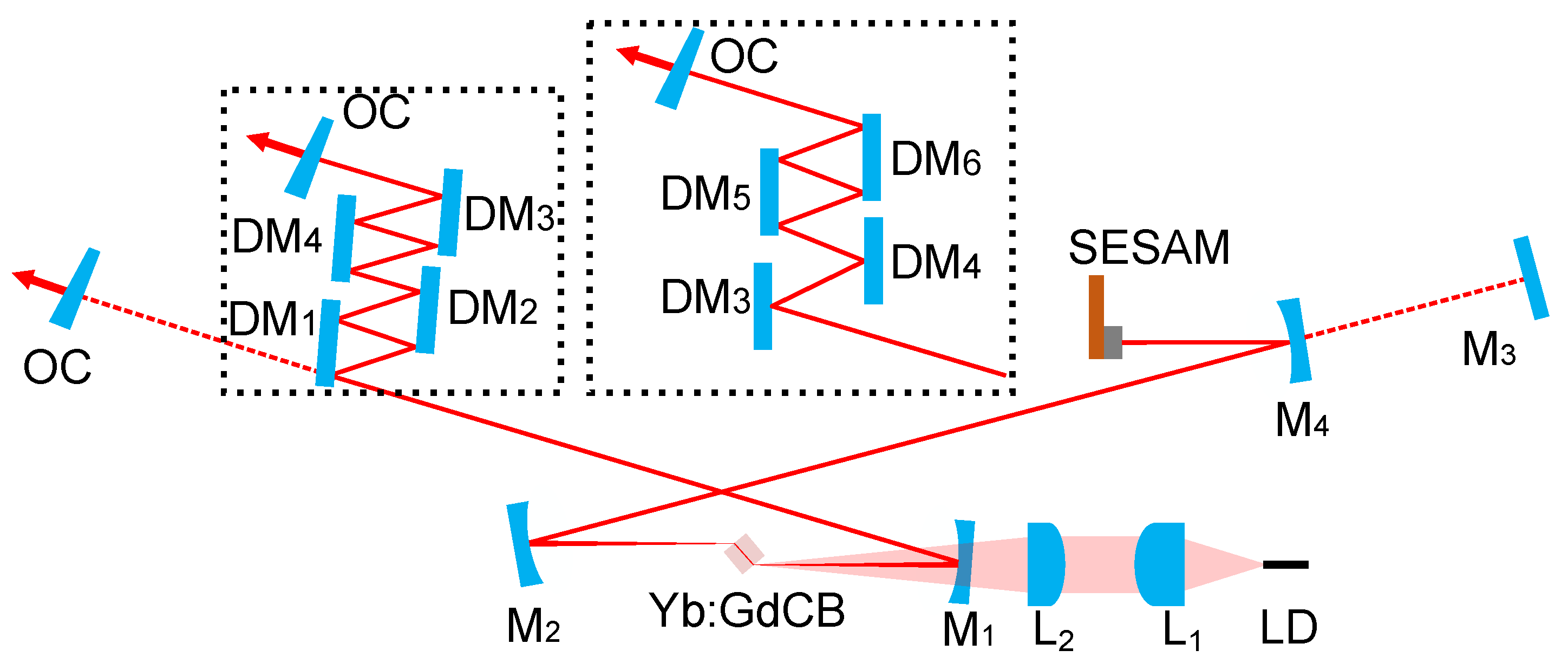
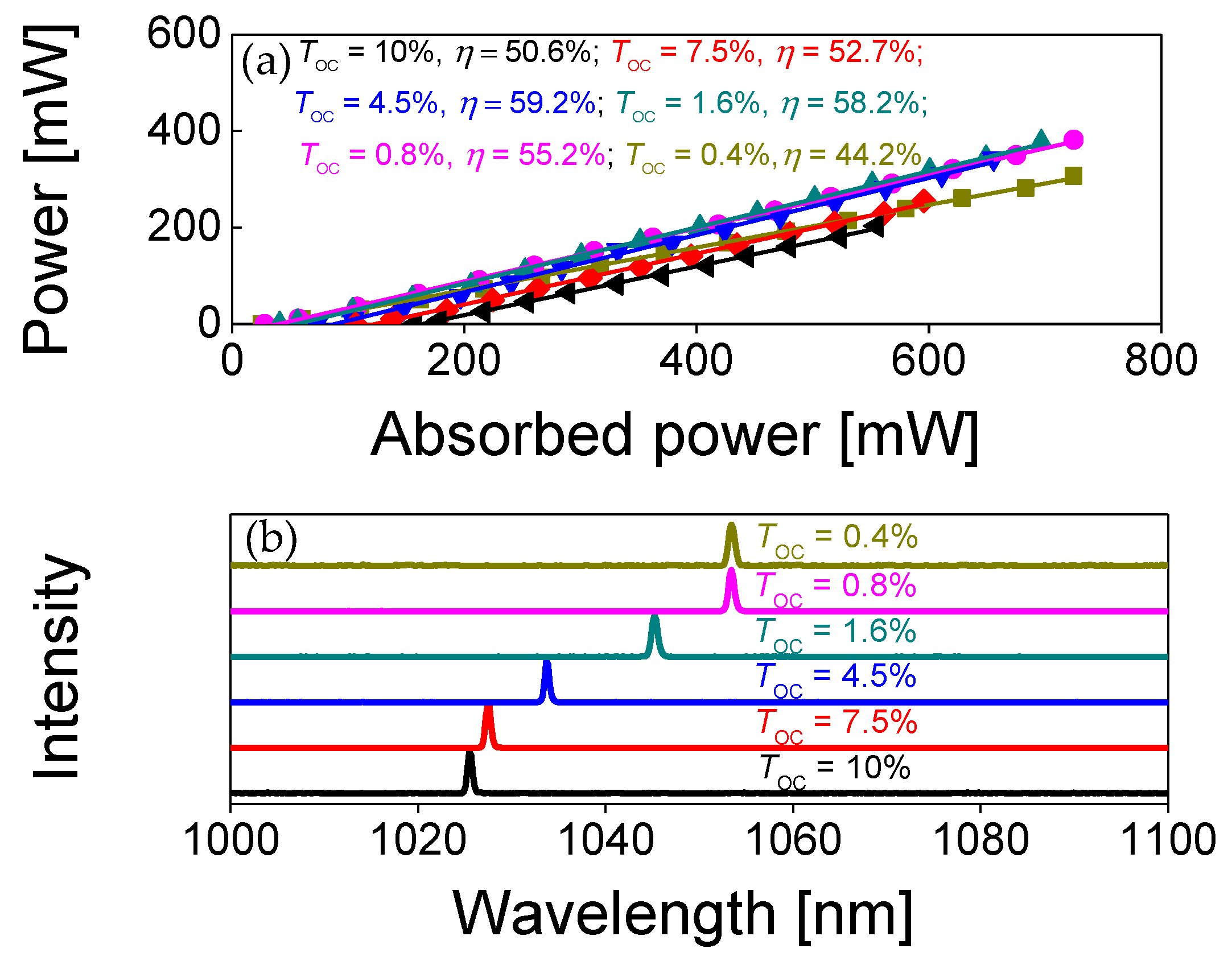
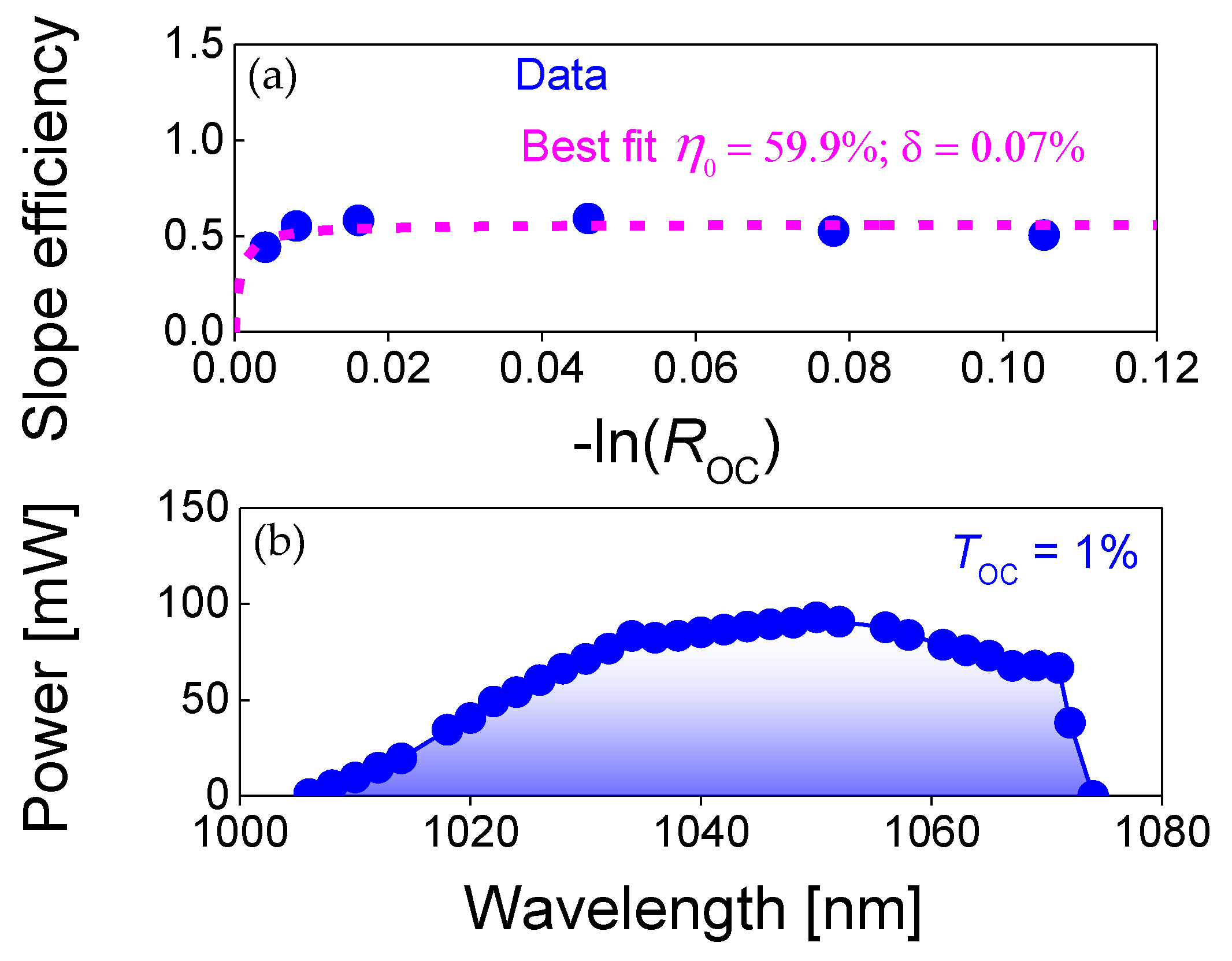
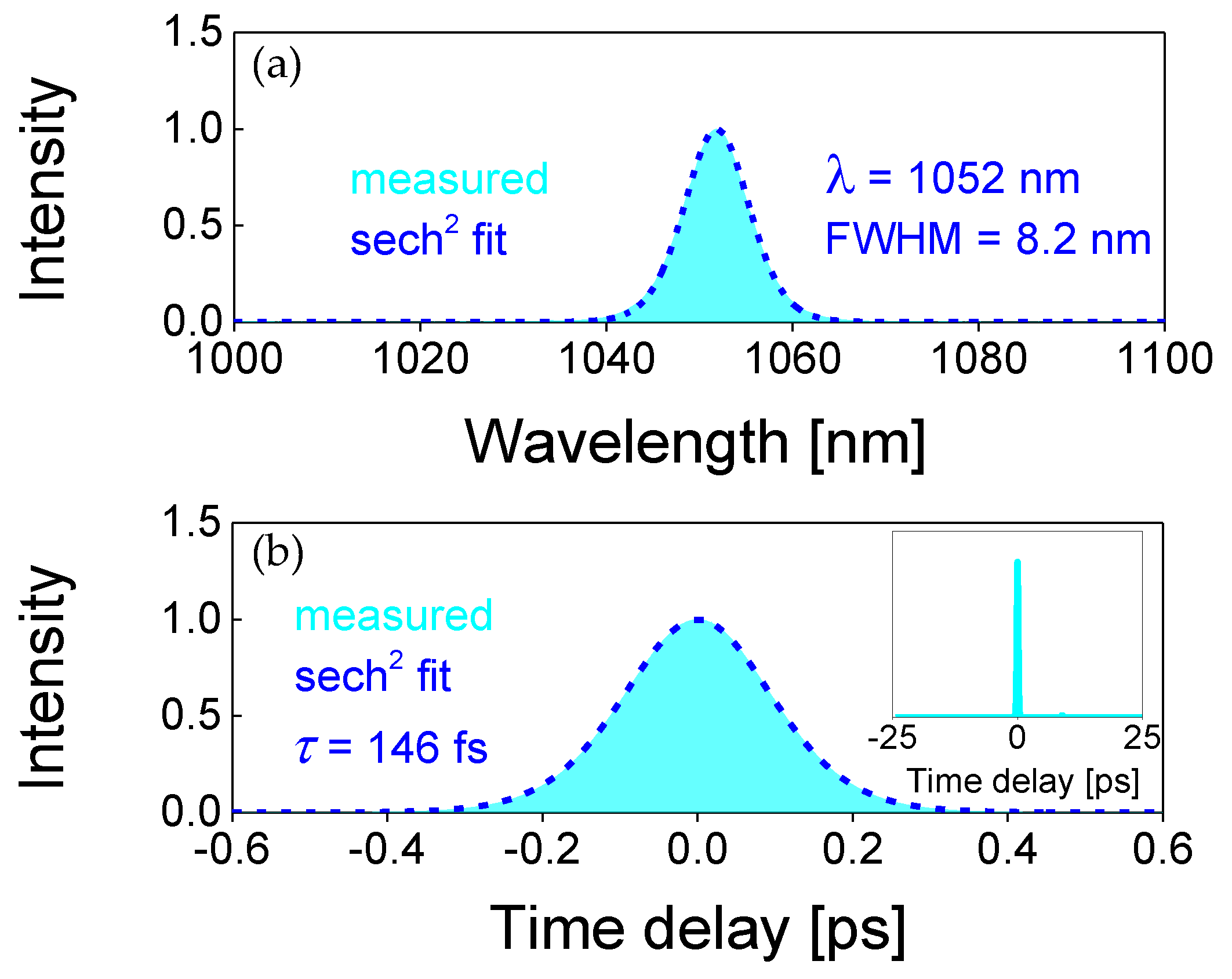
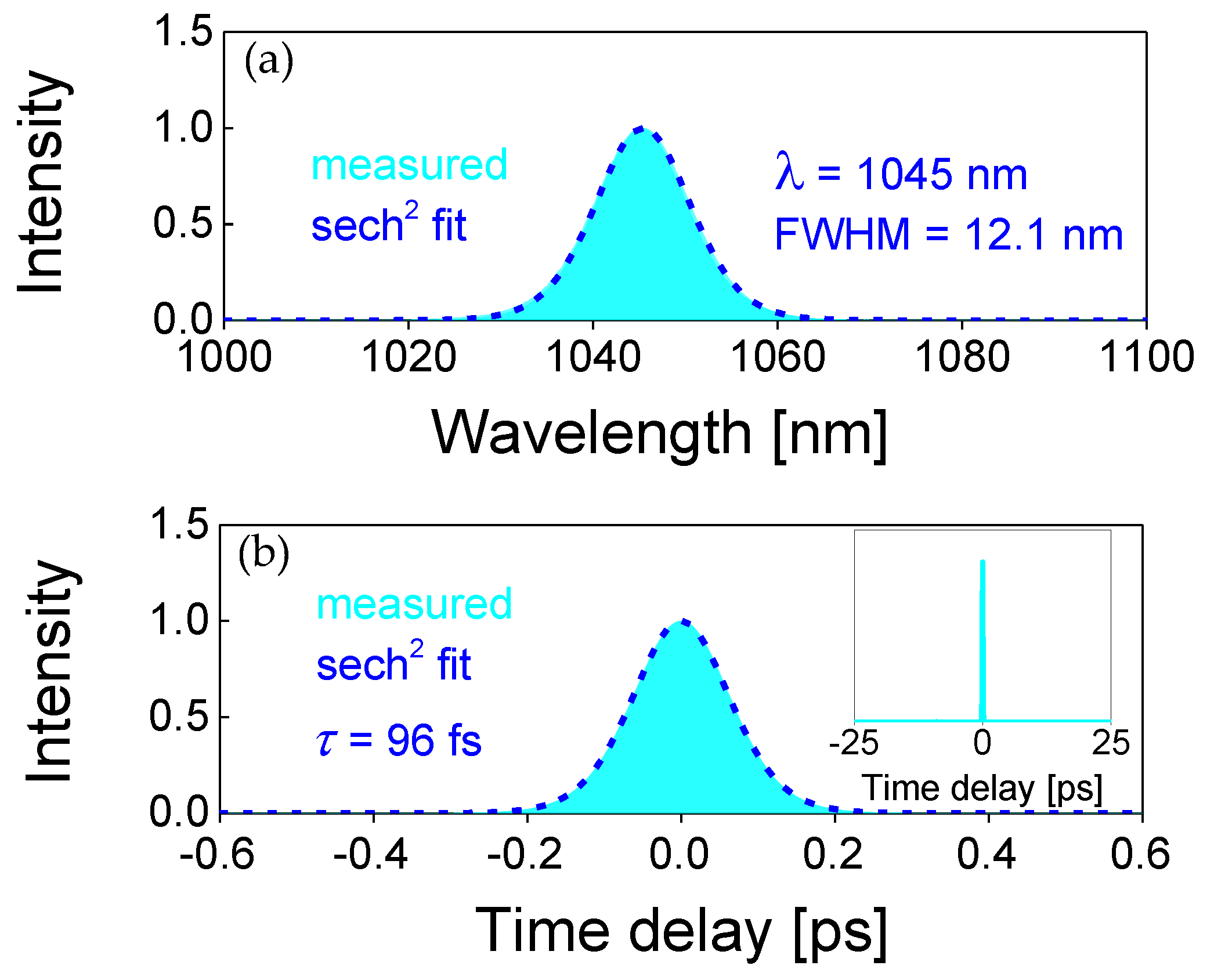
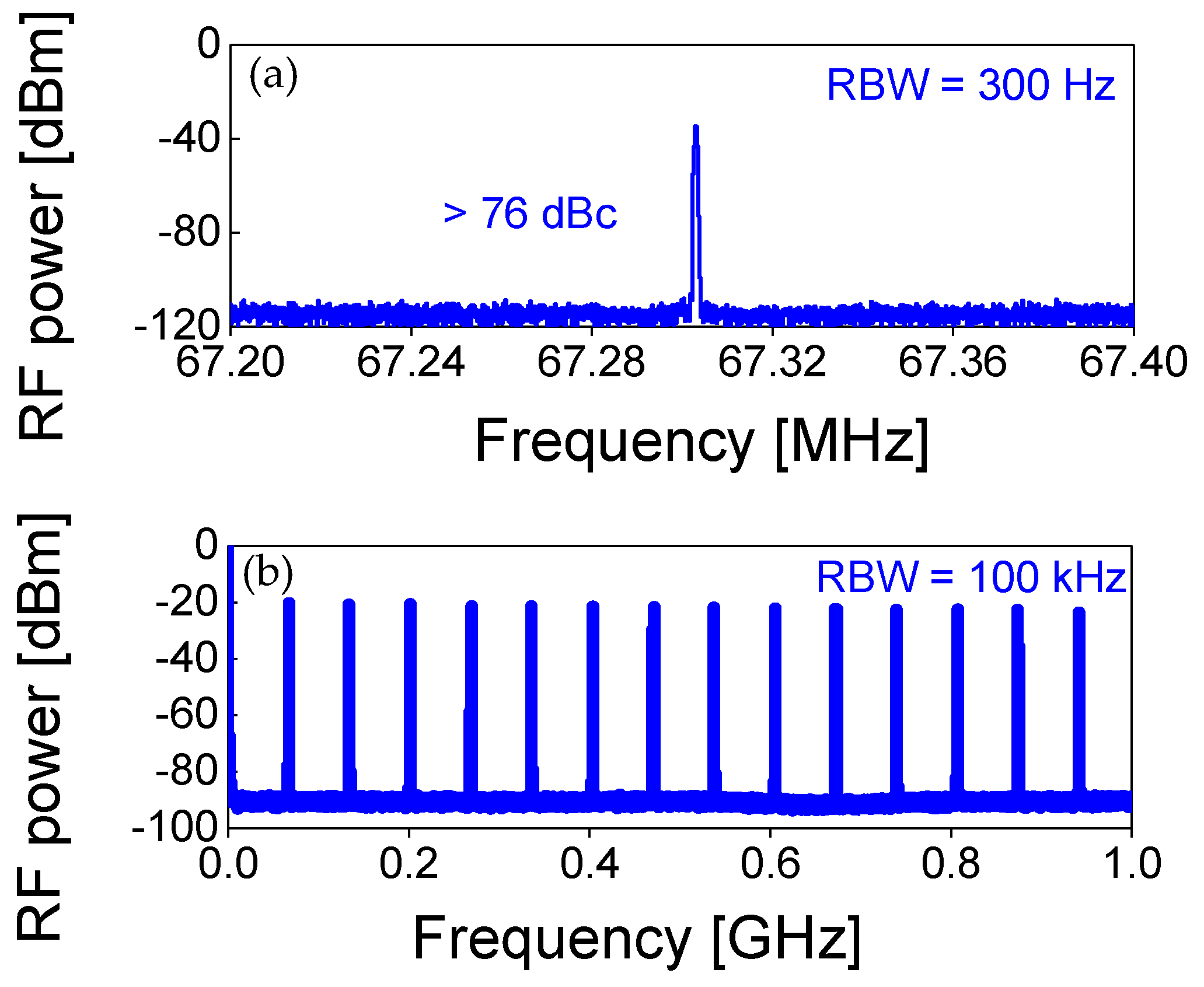
Publisher’s Note: MDPI stays neutral with regard to jurisdictional claims in published maps and institutional affiliations. |
© 2021 by the authors. Licensee MDPI, Basel, Switzerland. This article is an open access article distributed under the terms and conditions of the Creative Commons Attribution (CC BY) license (https://creativecommons.org/licenses/by/4.0/).
Share and Cite
Zeng, H.-J.; Lin, Z.-L.; Xue, W.-Z.; Zhang, G.; Pan, Z.; Lin, H.; Loiko, P.; Mateos, X.; Petrov, V.; Wang, L.; et al. SESAM Mode-Locked Yb:Ca3Gd2(BO3)4 Femtosecond Laser. Appl. Sci. 2021, 11, 9464. https://doi.org/10.3390/app11209464
Zeng H-J, Lin Z-L, Xue W-Z, Zhang G, Pan Z, Lin H, Loiko P, Mateos X, Petrov V, Wang L, et al. SESAM Mode-Locked Yb:Ca3Gd2(BO3)4 Femtosecond Laser. Applied Sciences. 2021; 11(20):9464. https://doi.org/10.3390/app11209464
Chicago/Turabian StyleZeng, Huang-Jun, Zhang-Lang Lin, Wen-Ze Xue, Ge Zhang, Zhongben Pan, Haifeng Lin, Pavel Loiko, Xavier Mateos, Valentin Petrov, Li Wang, and et al. 2021. "SESAM Mode-Locked Yb:Ca3Gd2(BO3)4 Femtosecond Laser" Applied Sciences 11, no. 20: 9464. https://doi.org/10.3390/app11209464
APA StyleZeng, H.-J., Lin, Z.-L., Xue, W.-Z., Zhang, G., Pan, Z., Lin, H., Loiko, P., Mateos, X., Petrov, V., Wang, L., & Chen, W. (2021). SESAM Mode-Locked Yb:Ca3Gd2(BO3)4 Femtosecond Laser. Applied Sciences, 11(20), 9464. https://doi.org/10.3390/app11209464






